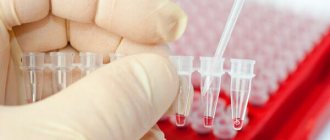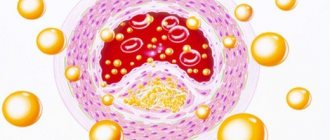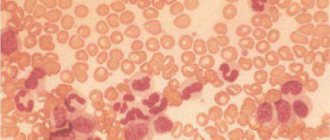Ekaterina Smolnikova
Practicing endocrinologist (10 years of experience). He has extensive experience working in private and public clinics in Russia.
Ask a Question
Bad habits: smoking, alcohol, disordered and unbalanced diet, uncontrolled use of medications contribute to diseases of the gastrointestinal tract, and especially disorders of the pancreas. The most dangerous of them is infected pancreatic necrosis. Mortality with such a lesion reaches 85%. Diagnosis of this and other gastrointestinal diseases is complex and consists, among other things, of blood biochemistry, which determines the level of lipase , one of the pancreatic enzymes. Let's look at what happens in the body when lipase is elevated in the blood.
Lipase - what is it?
An enzyme essential for normal digestion is lipase. It breaks down triglycerides (fats/lipids) into glycerol and carboxylic acids. Lipase is also important in the processing of vitamins (retinol, calciferols, tocopherol, phylloquinone, prenylmenaquinone) and linoleic, linolenic, arachidonic, eicosapentaenoic and docosahexaenoic acids.
It is produced by a variety of organs, depending on its origin, and is divided into:
- synthesized by the lungs (pulmonary);
- produced by the intestines;
- gastric (of particular importance in infancy, when the pancreas has not yet begun its production of enzymes);
- leukocyte;
- pancreatic;
- in infants, in the oral cavity (for the absorption of mother's milk) - lingual.
Pancreatic lipase plays an important role. Its content in human plasma is constant. But if degenerative processes occur with pancreatic acid cells, then the amount of lipase increases.
Fat-processing enzyme and other pancreatic juice enzymes
Lipase is a hydrolytic enzyme (it accelerates the hydrolysis of lipids into glycerol and fatty acids). This enzyme, having group specificity, is not attached to any one substrate, such as urease, which catalyzes the breakdown of urea. Lipase is produced by many organs and tissues, therefore, depending on the place of its production, they are distinguished:
- Pulmonary;
- Hepatic;
- Intestinal;
- Lingual (this type of enzyme is synthesized in the oral cavity, it is present mainly in infants, since it breaks down the fats contained in milk; with age, the need for lingual lipase disappears, so its production in adults is quite insignificant);
- Pancreatic (this will be discussed in the publication).
In the blood plasma, in addition to pancreatic lipase, there is lipoprotein lipase, which is also called a brightening factor for its functional task - to catalyze the breakdown of chylomicrons and, due to this, brighten the plasma.
The most important place among the enzymes that take on the function of breaking down fats belongs to pancreatic lipase. The pancreas is responsible for the production of this enzyme, which produces it and stores it in acinar cells in an inactive form. Following the entry of food into the duodenum, lipase also penetrates through the pancreatic duct into the small intestine, where it enters an active state in order to immediately begin its immediate tasks - the breakdown of lipids.
It should be noted that lipase is not the only enzyme supplied by the pancreas, because other substances must also be broken down. Pancreatic juice, which has a pronounced alkaline reaction (pH more than 10), contains enzymes that can deal with carbohydrates (amylase) and proteins (proteases) that arrived with food.
Indications for lipase testing
This laboratory test is prescribed when there are suspicions of pancreatic dysfunction:
- severe abdominal pain, often girdling;
- body hyperthermia;
- vomit.
In addition, the value of lipase in blood or urine samples may indicate the progress of the following diseases:
- cancerous formations;
- cholelithiasis, bile duct dyskinesia, cholecystitis, cholangitis;
- pathological changes in the pancreatic parenchyma: pancreatitis;
- piggy;
- acute cholecystitis;
- chronic liver diseases;
- diabetic ketoacidosis;
- obstruction of the small intestine;
- impairment of all kidney functions;
- mammary cancer.
Analysis for this enzyme in 98% of cases gives an accurate answer about the presence of pancreatic diseases. If a diagnosis has already been made, the study will show how effective the treatment is.
Lipase paired with amylase
The reason for prescribing tests such as enzymes produced by the pancreas are, for the most part, severe symptoms of acute conditions of the digestive system:
- Soreness, which is called “shingles”, because it affects not only the location of the gland. Starting somewhere in the epigastric region and quickly spreading to both hypochondrium, the pain moves to the back and chest, its intensity is so great that patients cannot restrain groans and screams;
- Fever usually does not occur immediately; body temperature rises as complications develop;
- A person’s suffering is not limited to painful nausea; it is accompanied by “fountain” repeated vomiting, which does not alleviate the condition;
- Attempts to eat lead to a worsening of the situation (the pain intensifies, vomiting continues, so the desire to even look at food disappears);
- The cardiovascular system, for its part, reacts by lowering blood pressure and increasing heart rate.
An increased concentration of lipase strongly indicates problems in the pancreatic parenchyma, so the study of this lipolytic enzyme in the blood plasma, as usual, is prescribed after another analysis - the determination of glycoside hydrolase (alpha-amylase) in the blood. Moreover, this enzyme (lipase) often turns out to be more informative, since its sensitivity and specificity are higher. For example, lipase in the blood is increased (very significantly - up to 200! times) after 4-7 hours (peak - after 24 hours) and, if inflammation subsides, the concentration returns to normal after 1 - 2 weeks.
Amylase behaves a little differently in this regard: increased activity is noted after 6–12 hours, and the levels of the glycolytic enzyme, which catalyzes the reaction of starch and glycogen breakdown, return to normal within 2 days to a week (of course, if the process in the organ itself ends safely) .
In general, changes in these two indicators increase with the development of an inflammatory reaction in the pancreatic parenchyma, and then decrease if the reaction declines, moving, one might say, synchronously. When both parameters are determined, acute pancreatitis can be diagnosed in 98% of cases.
Meanwhile, high rates do not always agree with the severity of the pathological condition, so relying only on the numerical values of glycolytic (alpha-amylase) and lipolytic (lipase) enzymes in the blood is not worth it.
Undoubtedly, first of all, an increased concentration of lipase in the blood makes one suspect acute pancreatitis. However, particularly complex situations require differentiation of this acute condition from other, clinically similar and equally dangerous diseases, therefore the range of indications for prescribing such an analysis is highlighted:
- An inflammatory reaction that suddenly started and began to develop rapidly in the tissue of the pancreas itself (acute pancreatitis);
- Problems that suddenly arise due to the formation and accumulation of stones in the nearest “neighbor”, the oval sac - the gallbladder (acute cholecystitis);
- Chronic inflammatory process localized in the parenchyma of the pancreas (chronic pancreatitis) in the acute phase;
- Perforated gastric ulcer;
- Renal failure (both acute acute renal failure and chronic renal failure);
- Diabetes mellitus (diabetic ketoacidosis - DKA, which is more typical for type 1 diabetes);
- Severe damage to the liver parenchyma (cirrhosis);
- High (small intestinal) intestinal obstruction;
- Chronic alcoholism;
- Organ transplantation.
And again, laboratory diagnostics are not limited to the study of only one lipolytic enzyme in the blood plasma; it is advisable to include in the protocol the determination of other enzymes, in particular alpha-amylase.
Preparation for the study of lipase activity does not stand out in any way among the preparatory activities for other biochemical tests. A patient interested in receiving a reliable answer for the first time should go rested, calm, and hungry (stop eating 12–14 hours before the test). By the way, you should cancel your usual smoking breaks half an hour before venipuncture or forget about cigarettes that morning altogether.
Symptoms of lipase deficiency and excess
When should you be wary and consult a doctor? If the consistency of the stool changed to liquid, abdominal cramps appeared, appetite disappeared and weight began to disappear, periodic feelings of nausea, vomiting, flatulence, general weakness and low physical activity appeared. In addition, sometimes your body temperature may rise slightly.
All these symptoms indicate both an excess and a lack of lipase. The only thing is that body hyperthermia most likely indicates an excess of the enzyme level.
Purpose of lipase in the human body
So, the main mission of any type of lipase is the processing of fats, their breakdown and fractionation. Also, this substance is actively involved in energy exchange, promotes the absorption of polyunsaturated fatty acids and certain vitamins.
The most important enzyme is produced by the pancreas. Pancreatic lipase is an enzyme with the help of which lipids are absorbed completely and completely. It enters the digestive tract, where, under the influence of colipase, which is also a pancreatic enzyme, it combines with bile acids and is converted into an active form. Pancreatic lipase plays an important role - it breaks down triglycerides (neutral fats) into two components: glycerol and higher fatty acids.
Carrying out analysis
To conduct the study, venous blood is taken. There are a number of dietary restrictions before taking the test. So you need to exclude the following foods within 12 hours before: fatty, spicy, spicy, and even better, if you abstain from them for 4 days. Like most other blood tests, it must be taken on an empty stomach and in the morning, preferably before noon. If the patient is scheduled for an x-ray on the same day, you may want to consider rescheduling the day for the blood draw. In emergency cases, when the patient’s life is at stake, the analysis is carried out without specified conditions.
Article on the topic:
Can I drink water before taking a blood test?
In modern medicine, two methods are accepted for determining the amount of enzyme in the blood: immunochemical and, the most popular and fastest, enzymatic.
If the indicators exceed the norm
If lipase is elevated, should you sound the alarm? Yes, you definitely need to pay close attention to this fact. And only a doctor, using tests and additional examination methods, can make an accurate diagnosis. After all, lipase is an enzyme involved in many metabolic processes, and only a specialist can determine which organ is suffering.
Lipase is elevated in the following diseases:
- Pancreatitis. This enzyme becomes more abundant in acute forms of the disease, as well as during exacerbation of the chronic process.
- Biliary colic.
- Trauma to the pancreas is usually accompanied by a sharp rise in this enzyme.
- Neoplasms in the pancreas.
- Chronic pathologies of the gallbladder contribute to a large volume of lipase production.
- The presence of a cyst in the pancreas.
- Blockage of the pancreatic duct by a stone or scar.
- Intrahepatic cholestasis.
- Acute intestinal obstruction.
- Peritonitis.
- Intestinal infarction.
- Perforated stomach ulcer.
- Perforation of internal organs.
- Parotitis.
As you can see, the list of diseases in which the level of lipase in the blood increases is quite large. Add to it the numerous metabolic disorders in the body that accompany diabetes, gout or obesity, as well as cirrhosis of the liver or long-term improper use of medications, and the list will double. It is worth remembering that lipase is an enzyme that actively participates in the metabolic process, so any operation can also provoke its increased production in the body.
Therefore, you should never make a diagnosis yourself, solely based on tests and reading medical books. Only a specialist, relying on a set of other studies, can accurately identify the cause of the pathology and develop the correct recommendations for treatment.
Reasons for deviations from the norms
An important diagnostic indicator is an increase in the amount of lipase in the blood plasma. An increase in this indicator indicates that the following pathological processes occur in the pancreas:
- Destruction of gland cells, as a result of which a high amount of lipase, as well as other enzymes, is released into the blood;
- Retention of pancreatic juice in the ducts, resulting from stones, tumors of the duct itself or the duodenum.
But most often these processes occur either simultaneously or as a consequence of one another.
Low levels of the enzyme indicate the development of conditions such as:
- cystic fibrosis;
- stomach ulcer;
- cancerous formations;
- peritonitis;
- chronic course of pancreatitis;
- hyperlipidemia;
- diabetes;
- Crohn's disease;
- high blood pressure.
Reduced lipase concentration
Although there is not much of an enzyme that accelerates the breakdown of fats in the blood plasma, certain conditions further reduce its amount. If the analysis shows that lipase in the blood is low, then you will have to look for the reason. Most often the case concerns a chronic inflammatory process in the pancreas - a fairly common pathology among various age groups. The main prerequisite for the formation of such a pathology, of course, is primarily considered to be alcoholism, but we should not forget that most people from an early age put a strain on the organ, giving preference to “goodies” rather than “healthy things.” Although, in addition to this, there are a number of circumstances that also negatively affect the condition of this parenchymal organ.
A laboratory test such as determining lipase in blood plasma is quite applicable if there has been chronic inflammation of a given localization for years, but we should not forget that significant damage to organ tissue during a long process can lead to the opposite effect - the concentration of the enzyme will be reduced. In addition, lipase is reduced in other, although not so common, cases, for example:
- For malignant tumors (of course, with the exception of pancreatic cancer);
- Those who like to fill their daily diet with predominantly fatty foods (almost all the enzyme is wasted working with fats);
- If for some reason the functional abilities of the pancreas decrease, due to which the production of enzymes decreases;
- Lipase is reduced in cystic fibrosis of the pancreas (cystic fibrosis, a serious systemic pathology inherited in an autosomal recessive manner, which is characterized by damage to the exocrine glands and profound functional disorders of the respiratory system).
Lipase activity will be reduced due to a rare surgical procedure - pancreatectomy. Such an operation is carried out when a person’s life is in question and, in order to save it, doctors decide on the need to use radical methods. A reduced lipase concentration will be observed both after partial (mainly if the operation affects the head and part of the body) and after complete removal of the organ.
Lysosomal acid lipase deficiency (LALD)
Congenital and inherited deficiency of specific lysosomal enzymes causes lysosomal diseases. The incidence of such diseases is quite low, but the danger from such conditions is very high. Thus, DLCL (lysosomal acid lipase deficiency) causes Wolman's disease (develops in infancy) and cholesteryl ester storage disease (less progressive and characterized by damage to older people).
Wolman disease without enzyme replacement therapy (for example, the use of Sebelipase alfa) is fatal in the first year of life. This disease has a very rapid course, causing liver failure, enlarged spleen, and paralytic intestinal obstruction. Diseases of accumulation of cholesterol esters are distinguished by a weaker nature of development, the liver is affected and dyslipidemia develops (a condition that provokes the development of atherosclerosis).
Treatment of lysosomal diseases consists of lifelong enzyme replacement therapy, which normalizes the level of transaminases, liver and spleen volumes, and improves the number of surviving patients. The prognosis of diseases, with early diagnosis and prevention of degenerative processes in the liver, is favorable.
Article on the topic:
What is lipomatosis and pancreatic lipoma? What are the dangers and the main methods of treatment?
Decreased lipase levels
There are fewer factors that cause a decrease in lipase relative to the norm than those that provoke its increase.
Lipase is reduced in cases where:
- A malignant tumor is forming in the body.
- The pancreas is not functioning well or has been removed.
- The patient has cystic fibrosis.
- With a predominance of fatty foods in the diet.
- For chronic pancreatitis.
- For diseases of the stomach and gastrointestinal tract.
- For inflammation of the gallbladder.
- Hereditary characteristics cause an increase in the lipid environment of the body.
When lipase is low, treatment cannot be determined immediately without further testing. Therefore, the best thing you can do if you find problems with this indicator is to immediately contact a specialist.
Fluctuations in lipase levels should be monitored primarily by people with problems:
- gastrointestinal tract;
- metabolism;
- pancreas.
Regular monitoring of this indicator will ensure the possibility of preventing sudden attacks of diseases and further complications.
Factors affecting blood lipase levels
Acute and chronic pancreatitis, trauma, pancreatic cancer, and duct obstruction lead to an increase in lipase levels in the blood.
To a decrease in indicators: cystic fibrosis, surgical removal of the pancreas, decreased functionality of the gland. But we must not forget that taking a number of drugs significantly distorts laboratory results. Such as non-steroidal anti-inflammatory drugs, analgesics, heparin, oral contraceptives, captopril, corticosteroids, furosemide. The development and progress of a disease such as hemolysis (destruction of red blood cells) can significantly affect the results of studies.
Indications
The lipase synthesized by the pancreas is of greatest diagnostic importance. When organ cells are renewed, some of the enzymes enter the bloodstream. The enzyme enters the kidneys and then enters the blood again.
If pancreatic tissue is damaged as a result of disease or injury, there is a significant increase in lipase levels in the blood. Therefore, most often, an analysis for the content of this enzyme is prescribed in the process of diagnosing acute pancreatitis. This disease is characterized by the following changes in lipase levels in the blood:
- the concentration of the enzyme in the blood increases within 4-8 hours after the first attack;
- the maximum enzyme content is observed one day after the first manifestation of the disease;
- the high concentration remains for 6-7 days, then begins to gradually decrease.
Advice! When diagnosing acute pancreatitis, a comprehensive biochemical analysis is prescribed, during which the concentration of two enzymes is determined - lipase and amylase. This analysis is highly informative; it can be used to diagnose acute pancreatitis in 99% of cases.
If pancreatitis is chronic, then an analysis of the concentration of lipase in the blood is less informative. Cells affected by chronic inflammation cease to synthesize enzymes in the required quantities. Therefore, with this disease, the enzyme content is normal or even reduced.
In addition, an analysis for the content of this enzyme can be prescribed when diagnosing the following diseases:
- acute cholecystitis;
- cirrhosis of the liver;
- renal failure;
- obstruction of the small intestine;
- alcoholism;
- diabetic ketoacidosis;
- mumps epidemic (a comprehensive analysis for amylase and lipase is required; with mumps, the content of the first enzyme increases, lipase remains within normal limits).
Advice! A test for lipase levels may also be prescribed during a preventive examination, for example, before admission to a hospital.
Normalization of lipase levels
It doesn’t matter in which direction the lipase level deviates from the norm, in any case, this indicates a malfunction in the gastrointestinal tract that needs to be eliminated as quickly as possible. Classic treatment includes both medication and a constant diet, and in some cases (in the presence of tumors) surgical procedures. If the primary disease is associated with the pancreas, medications are prescribed:
- regulating the production of lipase;
- myotropic, antihistamine, anticholinergic drugs;
- anti-inflammatory drugs;
- gastrozol, omez, omefez, losek, ultop, controlok, sanpraz.
For gallbladder diseases: antibacterial therapy and enzyme preparations (Creon, Festal, Pancreatin and others). The dosage and regimen are prescribed by the doctor, based on the patient’s enzyme levels.
In addition, following a diet, giving up bad habits, and in the acute period, even fasting show quite good results in the process of normalizing digestion and, accordingly, lipase levels.
In cases of significant decrease in enzyme levels, regular physical activity is recommended. A direct effect, with a downward trend, on the level of triglycerides in the blood and cholesterol has been proven. Nutritional supplements of any origin also give good results. A low-fat diet rich in vegetables and fruits will not only normalize enzymes, but will also have a generally positive effect on the general condition of the body.
Article on the topic:
What to do if your pancreas hurts? First aid at home
Norms and deviations
When performing tests for lipase, the enzyme level does not depend on gender:
- for the adult population (men and women), the norm for the content of this enzyme is up to 190 U/ml;
- for patients under 17 years of age, the norm is slightly lower - up to 130 U/ml.
Excess
If the norm is increased, then this condition may have the following reasons:
- Pancreatitis in acute form. With this disease, the norm can be exceeded several tens of times.
- Chronic pancreatitis. In this disease, lipase is not always elevated. Usually, the excess is not too significant, it lasts about seven days, and then begins to decrease. If, in the chronic form of the disease, the norm of lipase content is exceeded 10 times or more, then this indicates an extremely severe course of the disease.
- Neoplasms in the pancreas. Benign and malignant cysts and tumors can cause changes in blood composition;
- Intestinal obstruction or infarction.
- Gallbladder diseases, cholestasis.
- Diseases in which fat metabolism is disrupted - obesity, diabetes, gout.
- Peritonitis. In this case, inflammation of the disease covers all organs of the abdominal cavity, including the pancreas.
An increase in the level of this enzyme during mumps is evidence that the inflammation has spread to the pancreas. In addition, a sharp increase in enzyme levels is observed with injuries leading to rupture of internal organs.
Low level
A decrease in the enzyme level below 7 U/l can be caused by the following reasons:
- hereditary diseases associated with metabolic disorders: hyperlipidemia, cystic fibrosis;
- decreased pancreatic function due to pathological changes in organ tissue;
- oncology (the tumor can be localized anywhere except the pancreas).
So, the digestive enzyme lipase is a substance that takes part in the reactions of fat breakdown. An analysis for the content of this enzyme is most often prescribed in the process of diagnosing acute pancreatitis. However, changes in the level of this enzyme can also be observed in other diseases.
Prevention of lipase surges
Like any other malfunction in the body, lipase surges can be avoided by following some rules:
- Diet. It is useful to eat small and often, dividing portions into smaller ones. Don't skip breakfast. Compliance with sanitary and hygienic standards.
- Diet. Avoid smoked, fried, spicy, too salty foods. But fiber-rich foods can be consumed in unlimited quantities. Cabbage, legumes, radishes, mustard, and garlic cause gas formation in the intestines, so it is worth limiting their consumption.
- Don't overeat. The standard serving for an adult is 300-400 ml.
- Drink enough fluids. It is recommended to drink a glass of warm water half an hour before meals.
- Keep your body weight under control. Excess weight aggravates the course of diseases and provokes increased symptoms.
- Quitting alcohol. Many alcoholic drinks contain dyes, preservatives, sugars and flavorings, which negatively affects the functioning of the pancreas. Although conditionally safe doses of ethanol have been established, it is better to refrain from drinking it completely.
- Minimize the amount of stress, walk more, relax and get enough sleep.
- If you smoke, you should definitely give up cigarettes. Tar and nicotine significantly weaken the body and subject it to additional stress.
- Increase your level of physical activity. Swimming strengthens you well, improves intestinal motility, take advantage of every opportunity to move more often.
- If you have diabetes, monitor your blood sugar levels especially carefully.
- Follow all the recommendations of your doctor, undergo regular medical examinations, and if you have chronic diseases, regularly take tests for control.
- Taking many medications can provoke the development of diseases of the gastrointestinal tract, so be sure to consult your doctor before taking it.
Timely diagnosis of diseases of the gastrointestinal tract, and especially the pancreas, is the key to quickly relieving the main symptoms of the disease. And a huge role in this diagnosis belongs to lipase analysis, which helps to accurately diagnose and begin therapy as quickly as possible, avoiding serious consequences.
Function and role of lipase in the body.
Pancreatic lipase molecule
The body is unable to absorb food in the form in which it enters the stomach. First, it must be broken down using various protein substances. Lipase is a digestive enzyme that helps dissolve and digest fats. This element is involved in the digestion process, being part of the pancreatic juice. It enters the intestines and there separates complex fats into acids and trihydric alcohol. Thanks to this process, the supply of fatty acids to the cells is ensured.
The main functions of lipase are:
- fat fragmentation,
- processing of vitamins A, D, E, K,
- melting of fatty acids
- involvement in energy metabolism,
- regulation of plasma lipid levels,
- stabilization of metabolism.
Enzyme activity occurs when fat enters the body. In the intestines, during the breakdown of fats, the bulk of it is found. During the process of regeneration of pancreatic cells, lipase units enter the plasma. The enzyme passes through the kidneys and is then reabsorbed into the blood. The presence of lipase in the bloodstream of a healthy person is almost constant.











